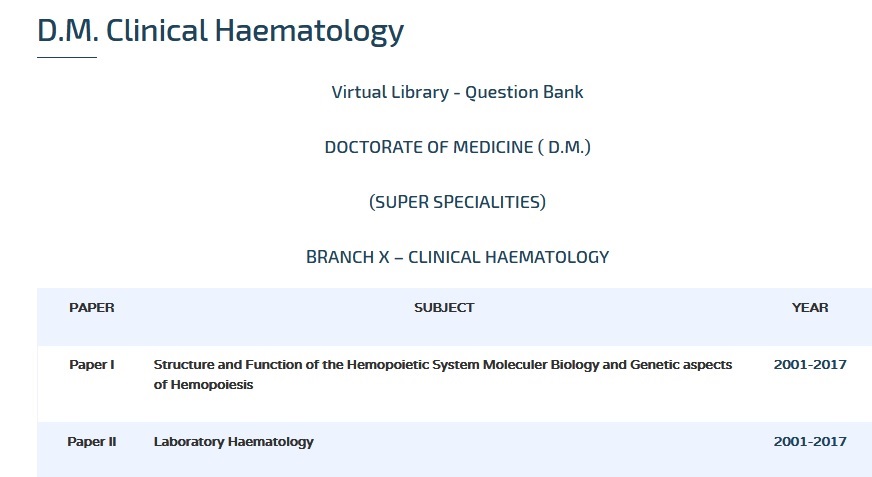Basic Sciences & Diagnosic Procedures In Rheumatology & Clinical Immunology DM Question Bank : web.tnmgrmu.ac.in
Name of the University : The Tamilnadu Dr. M.G.R. Medical University
Degree : D.M
Branch : Branch IX – Rheumatology
Subject Code/Name : 1351/BASIC SCIENCES AND DIAGNOSIC PROCEDURES IN RHEUMATOLOGY AND CLINICAL IMMUNOLOGY
Paper : I
Document Type : Question Bank
Website : web.tnmgrmu.ac.in
Download Model/Sample Question Paper :
1993-2000 : https://www.pdfquestion.in/uploads/web.tnmgrmu.ac.in/4485-1-161351KC.pdf
2001-2013 : https://www.pdfquestion.in/uploads/web.tnmgrmu.ac.in/4485-2-161351KU.pdf
TNMGRMU Diagnosic Procedures Rheumatology Question Paper
Sub. Code: 1351
D.M. DEGREE EXAMINATION
(Higher Specialities)
(Revised Regulations)
Branch IX – Rheumatology
Paper I : BASIC SCIENCES AND DIAGNOSIC PROCEDURES IN RHEUMATOLOGY AND CLINICAL IMMUNOLOGY
Q.P. Code: 161351
Time: Three hours
Maximum: 100 Marks
Related : TNMGRMU Clinical Pharmacology, Rehabilitation Surgery Special Problems Question Paper : www.pdfquestion.in/4490.html
August 2008
ANSWER ALL QUESTIONS :
Draw suitable diagrams wherever necessary. :
I. Essays: 2 x 20 = 40 Marks
1. Discuss genes that are important in lupus pathogenesis. Briefly describe the important epigenetic factors and various methodologies employed in the study of lupus genetics.
2. Discuss the role of peptidylarginine deiminase (PAD) in the immunobiology of Rheumatoid Arthritis.

II. Write short notes on: 10 x 6 = 60 Marks
1. B Lumphocytes.
2. Th 17 cells
3. Jumping genes.
4. TGF beta signalling in systemic sclerosis.
5. Minor salivary gland biopsy.
6. Myositic specific antibodies.
7. Antinucleosome antibodies.
8. Endothelial dysfunction.
9. Cartilage engineering.
10. Chronobiology and rheumatic diseases.
August 2009
I. Essays: 2 x 20 = 40
1. Discuss in detail about the various human major histo compatibility complexes and human leucocyte antigens, their association and clinical relevance in individual rheumatic diseases.
2. Describe in detail about the genetic basis, structure, immuno chemical properties, methods of measurements and pathophysiological role of anti ds – DNA in auto immune diseases.
II. Write short notes on: 10 x 6 = 60
1. Genomic effects of glucocorticoids.
2. Diagnostic arthroscopy.
3. Structure and functions of fibroblast.
4. Rheumatoid factor – uses and fallacies.
5. Bone markers in rheumatology.
6. Ultra structure of myofibril.
7. Role of leucotriens in chronic inflammation.
8. Elastin.
9. Methods of measurements of bone mineral density.
10. Uses of ultra sonography in rheumatology.
Sub. Code: 1351
I. Essays: 2 x 20 = 40 Marks
1. Describe the mechanism of tolerance, add a brief note on mechanism responsible in break down of tolerance.
2. What are biomarkers used in rheumatic diseases. Discuss them with reference to Osteoarthritis.
II. Write short notes on: 10 X 6 = 60 Marks
1. Monocytes.
2. Interleukin 17.
3. Anti-nucleosome antibody.
4. Immunoglobulin.
5. Arterial biopsy.
6. PCR in rheumatology.
7. Chondrocalcinosis.
8. Osteoclasts.
9. Complement system.
10.Antigen presenting cell.
August 2011
I. Elaborate on :
1. Describe the cell recruitment in the pathogenesis of arthritis and add a note on angiogenesis.
2. Write essay on the Neurologic regulation of inflammation.
II. Write notes on :
1. A Disintegrin and metalloproteinase (ADAM) family.
2. Immunoblotting.
3. Anti-streptococcal antibodies.
4. Role of Nitric oxide in rheumatic diseases.
5. Quantitative ultrasound.
6. T-cell vaccination.
7. IL-1 trap.
8. Capture enzyme immunoassay.
9. Arthrocentesis.
10. Chromatic associated antigens.
August 2012
I. Elaborate on:
1. Describe in detail about the B cell development B cell functions and immunoglobulin.
2. Discuss the morphology, classification and normal function of chondrocytes.
II. Write notes on:
1. What is spotted DNA microarrays?
2. What are regulatory T cells?
3. What are the products of neutrophils?
4. What are the main phases of the gait cycle?
5. How is the joint innervated?
6. How does bone resorption occur in rheumatoid arthritis?
7. What are integrins? Add a note on their functions.
8. What are the negative regulators of B cell activation?
9. What is the role of apoptosis in relation to rheumatic diseases?
10. What are the collagen markers? Discuss them in brief.
August 2013